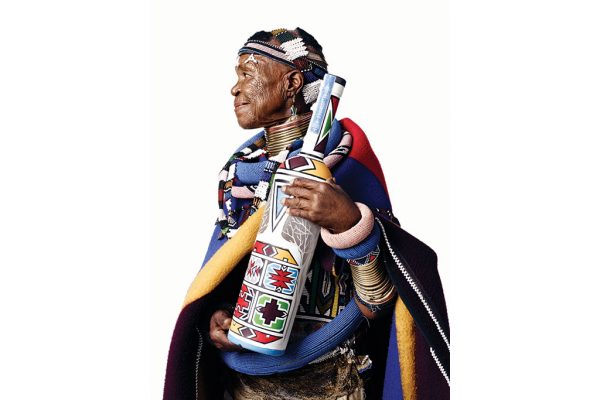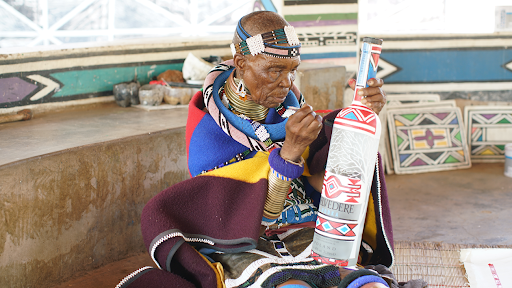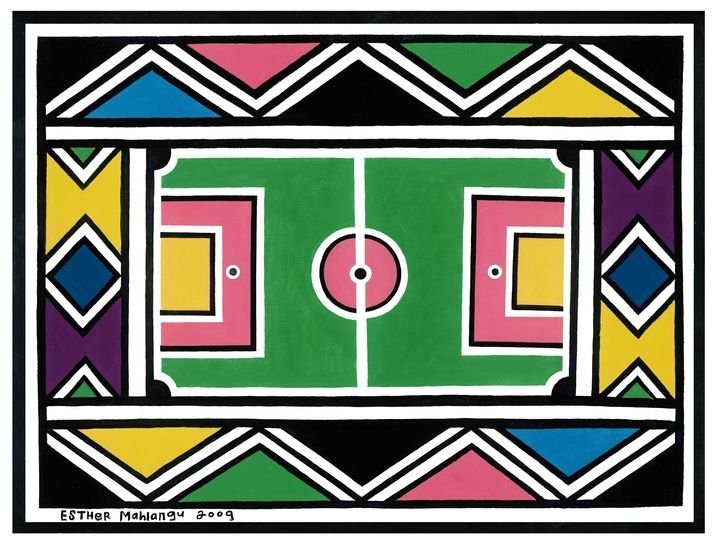How one of South Africa’s most famous artists perpetuates traditional Ndebele painting and uses art as activism.
‘To paint is in my heart and in my blood,’ says Esther Mahlangu. She may not know how to read or write, having never attended school, but she was born an artist. Aged 83 and considered a national treasure, she has devoted her life to sharing her cultural heritage with the world through her vibrant, geometric and symmetrical abstract paintings and murals in the Ndebele tradition. Among South Africa’s most famous living artists who has exhibited in some of the world’s most respected museums and counts celebrities Usher, Swizz Beatz, John Legend and Oprah Winfrey as collectors, she was the first person to transfer the time-honored Ndebele style of painting from the wall to canvas, effectively promoting and preserving the art form. She spends much of her time working on community projects in Mabhoko village in Mpumalanga province teaching boys and girls painting and beadwork techniques that were passed down to her from her mother and grandmother—so they can teach their children one day, having set up her own art school in the backyard of her home. She travels incessantly to spread her culture globally and ensure the survival of Ndebele art.
The Ndebele custom of painting the exterior walls of houses was traditionally performed by the women of the community, transmitted from one generation to the next. The elaborately-painted patterns and graphic elements composed of rectangle, triangle, chevron and diamond shapes heralded news of important life events such as a birth, death, wedding or a boy heading off to initiation school. ‘When you get married, you paint your first house,’ Mahlangu relates. ‘It’s very important to have straight lines and not zigzag lines because your family members will come and look. If your lines are perfectly straight, then you are a very good wife and can look after your family.’ A traditional art combining social and decorative functions, it also became a symbol of resistance against the Boer farmers initially, then against the British expansion and finally against the apartheid regime. A means of information and communication, the large wall paintings denoted combat, cultural ties and the affirmation of identity at the same time.
At 10 years old, Mahlangu used to watch her mother and grandmother painting their house. Longing to join them, when they took a break from painting, she would try her luck without their knowledge. But when they returned, they scolded her telling her never to do that again as her lines were skewed. She recalls, ‘Every single afternoon when they went to have a nap, I’d try to paint. I got into trouble every day until eventually they realized that in my heart I wanted to paint.’ Gradually she was granted a small space at the back of the house to paint, with daily inspections by her mother and grandmother.
Using a chicken feather rather than a paintbrush, Mahlangu applies thick black outlines and vivid colors. She creates her compositions without the help of preliminary drawings or a ruler for straight lines, painting freehand with incredible precision, and deciding on the shades as she proceeds. As with a younger generation of artists, Mahlangu may use acrylic paint today, which opened up an entirely new color palette, but when she first started, she worked with natural pigments she made herself and cow dung, limited to yellow, white, ocher, black and red hues. ‘Acrylic paints have allowed me to use many more colors than I could have with natural pigments,’ she notes. ‘What many find interesting about my artworks is that although they are based on traditional Ndebele designs, they are still very modern and current. They can fit into a home or office anywhere in the world and don’t appear dated.’ This move to blend tradition and modernity has elevated the art and helped to showcase the Ndebele people’s contribution to contemporary art.
Since the late 1980s, Mahlangu has traveled outside of South Africa. One of over 100 participating artists, the ground-breaking 1989 group exhibition Magiciens de la Terre (Magicians of the Earth) at the Centre Pompidou and La Villette in Paris that placed non-Western contemporary art on the international art map propelled her onto the global stage—a significant achievement for a black female artist at the time. The exhibition’s associate curator, Andre Magnin, had chanced upon her house on a research visit to South Africa two years prior, discovering ‘a work of absolutely exemplary color, very well-ordered geometric shapes that give the whole property an exemplary brilliance’ and immediately invited her to Paris for her first overseas show. By 1990, she started to receive invitations to create murals in public spaces in South Africa, Europe and the United States, and to exhibit in over 12 countries.
Big on collaboration, Mahlangu has successfully brought her people’s traditional art of painting into a new context, applying her artistic vocabulary to sculpture, ceramics, automobiles and even airplanes. Partnering with a variety of well-known brands such as Belvedere vodka, Fiat, British Airways and cult Swedish footwear label Eytys, she was the first African and first female artist to paint a BMW Art Car in 1991, following in the footsteps of the likes of Andy Warhol, Alexander Calder, Frank Stella, Roy Lichtenstein, Robert Rauschenberg and David Hockney since 1975 when the program was instituted. By painting a BMW 525i, Mahlangu transferred her tribe’s traditional means of expression to an object of contemporary technology. Twenty-five years later, BMW commissioned her to paint the interior wood panels of a BMW Individual 7 Series. She describes the partnership, ‘It was a great honor to have been invited to participate in the BMW Art Car project with so many respected global artists. This project played a major role in my career. My art has taken me all over the world and I have seen many places, I have painted many walls and objects, and my work is in many museums, but I am still Esther Mahlangu from Mpumalanga in South Africa. My heart was full of joy when BMW asked me again to paint for them.’
Continuing her role as cultural ambassador of the Ndebele, Mahlangu has earned an honorary doctorate from the University of Johannesburg and the French decoration of the Order of Arts and Letters for her contribution to the arts. In 2004, she collaborated with Nelson Mandela, painting on prints of drawings that he had done. ‘I was very humbled to do the paintings, but the main reason why I did them was because the artworks were to be sold to benefit education for youth,’ she discloses. ‘I love to paint and have been doing it my whole life. I will paint anything, as long as there’s a benefit where my culture can be preserved, where somebody growing up can value and never forget their Ndebele roots.’

Dr Esther Mahlangu.

Mahlangu in her hometown of Middelburg, province of Mpumalanga, South Africa.

Mahlangu teamed up with Belvedere for their RED campaign, a limited number of bottles have been adorned with her artwork.

A street mural in New York, honoring Esther Mahlangu.

Mahlangu was taught to paint at age ten by her mother and grandmother and has since exhibited all over the world.

Using a chicken feather rather than a paintbrush, Mahlangu applies thick black lines and vivid colours.

Mahlangu's collaboration with Nelson Mandela: painting on prints of drawings that he had done.

Mahlangu created a BMW ‘Art Car’ showcasing her unique and striking artistic style. Mahlangu was the first woman to create artwork for the Art Car project and joined the ranks of other notable artists including Ernst Fuchs and Andy Warhol.

Mahlangu’s other focus is to teach young girls something that is more than art. Her goal is to teach the village traditions of the Ndebele tribe and maintain the culture and keep it alive.